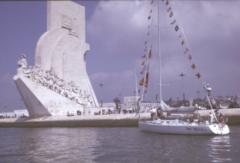A day trip from Oeiras
Lisbon, 15km to the east of Oeiras, is an historic port and the capital city of this seafaring nation. Just ten miles from the mouth of the River Tagus, or Tejo in Portuguese, Lisbon is blessed with a perfect natural harbour. This inland sea has provided a safe haven for shipping since the Phoenicians named it Allis Ubbo (delightful port), over 2,000 years ago.
The discoveries of the great explorers in the 15th Century brought huge wealth to Lisbon from trade with the New World and India. However, the great churches and public buildings on which this wealth was lavished have mostly disappeared. A violent earthquake, disastrous fire and huge tidal wave destroyed much of the city in 1755. The rebuilding that followed was strictly controlled, resulting in an elegant, if unimaginative, style to the city centre, the Praça do Comércio. The Alfama is Lisbon’s oldest and most memorable area, a warren of tightly packed houses and narrow stepped streets which tumble down the hill towards the River Tagus below the Moorish castle. The many historic monuments reflect styles from almost every era and the colonies of the Old Portuguese Empire.
 Sight seeing in Lisbon can be hard work, since the city is built on some steep hills. However, the numerous bars, coffee shops and local restaurants provide ample opportunity for relaxing as well. Cuisine’s from such imperial outposts as Brazil, Goa and Africa, make eating out in the city rewarding for the adventurous.
Sight seeing in Lisbon can be hard work, since the city is built on some steep hills. However, the numerous bars, coffee shops and local restaurants provide ample opportunity for relaxing as well. Cuisine’s from such imperial outposts as Brazil, Goa and Africa, make eating out in the city rewarding for the adventurous.
For sailors, the Museu de Marinha is worth visiting as it gives an interesting overview of the evolution of Portuguese sailing ships, with strong emphasis on the Age of Discoveries. Sailing up the Tagus into Lisbon, one passes the Padrâo dos Descobrimentos, the monument to the Age of Discoveries. Built to mark the 500th anniversary of the death of Prince Henry the Navigator, the monument shows the Prince on the bow of a caravel, flanked by the likes of Magellan, da Gama and Dias (see photo).
Public transport from Oeiras to and around Lisbon is excellent and can be a good way to see the city. The City’s eléctricos (trams) are the most fun and there are also three funicular railways and a huge street lift designed by a disciple of Eiffel. The tourism office issues daily tourist transport passes that allow unlimited use of public transport.
http://www.atl-turismolisboa.pt/